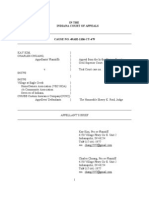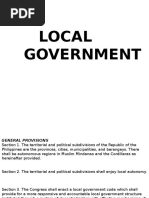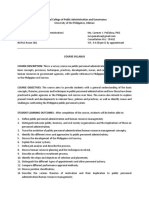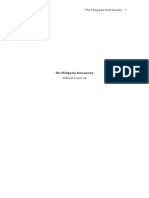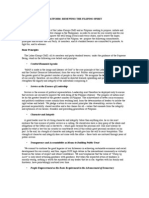0 ratings0% found this document useful (0 votes)
72 viewsLocal Government History and Backgound
Local Government History and Backgound
Uploaded by
Bernadette LlanetaThe document summarizes the history of local government in the Philippines from the pre-colonial period up until the American/Japanese period. In the pre-colonial period, the smallest community was called a barangay led by a datu. The Spanish period introduced a centralized government and formal local government units like municipalities headed by gobernadorcillos. Under American rule, the Municipal Code of 1917 established provincial and municipal governments and barrios led by lieutenants.
Copyright:
© All Rights Reserved
Available Formats
Download as PPTX, PDF, TXT or read online from Scribd
Local Government History and Backgound
Local Government History and Backgound
Uploaded by
Bernadette Llaneta0 ratings0% found this document useful (0 votes)
72 views20 pagesThe document summarizes the history of local government in the Philippines from the pre-colonial period up until the American/Japanese period. In the pre-colonial period, the smallest community was called a barangay led by a datu. The Spanish period introduced a centralized government and formal local government units like municipalities headed by gobernadorcillos. Under American rule, the Municipal Code of 1917 established provincial and municipal governments and barrios led by lieutenants.
Original Title
LOCAL GOVERNMENT HISTORY AND BACKGOUND
Copyright
© © All Rights Reserved
Available Formats
PPTX, PDF, TXT or read online from Scribd
Share this document
Did you find this document useful?
Is this content inappropriate?
The document summarizes the history of local government in the Philippines from the pre-colonial period up until the American/Japanese period. In the pre-colonial period, the smallest community was called a barangay led by a datu. The Spanish period introduced a centralized government and formal local government units like municipalities headed by gobernadorcillos. Under American rule, the Municipal Code of 1917 established provincial and municipal governments and barrios led by lieutenants.
Copyright:
© All Rights Reserved
Available Formats
Download as PPTX, PDF, TXT or read online from Scribd
Download as pptx, pdf, or txt
0 ratings0% found this document useful (0 votes)
72 views20 pagesLocal Government History and Backgound
Local Government History and Backgound
Uploaded by
Bernadette LlanetaThe document summarizes the history of local government in the Philippines from the pre-colonial period up until the American/Japanese period. In the pre-colonial period, the smallest community was called a barangay led by a datu. The Spanish period introduced a centralized government and formal local government units like municipalities headed by gobernadorcillos. Under American rule, the Municipal Code of 1917 established provincial and municipal governments and barrios led by lieutenants.
Copyright:
© All Rights Reserved
Available Formats
Download as PPTX, PDF, TXT or read online from Scribd
Download as pptx, pdf, or txt
You are on page 1of 20
MPA 208
LOCAL GOVERNMENT ADMINISTRATION
LOCAL GOVERNMENT
HISTORY AND BACKGOUND
I. Pre-colonial Period (before 1951)
II. Spanish Period (1951-1898)
III. American/Japanese Period
I. PRE – COLONIAL PERIOD
(before 1951)
PRE-COLONIAL PERIOD (Barangay)
Smallest community
Led ba a Datu – chieftain, wealthiest in the
community
Community is composed of:
› Datu (maharlika)
› Alipin (saguiguilid or namamahay)
Datu:
› Serves as a lawmaker, judge and executive
› Assisted by council of elderly
› His authority is mostly autocratic
PRE-COLONIAL PERIOD (Barangay)
Function is preservation of peace and
mutual protection from other barangays
Confederations of barangays is headed by the
chief or datu of the largest or wealthiest
barangay.
Due to lack of centralization because the power
of a datu is mostly confined to its own barangay
only, the Spaniards easiy penetrated the
Philippines which started the Spanish
colonization.
II. SPANISH PERIOD (1951-1898)
SPANISH PERIOD
Barangay organization was retained and datu
remianed as head the head.
But powers were already nominal and rectricted by
lay and ecclesiastical authorities.
His role is most dominant as executor of the
Spanish policy especially in terms of tax collection.
The existing local social configuration has been
utilized by the Spanish administrators in the
formation of highly centralized, autocratic
colonial regime.
SPANISH PERIOD
Rise of pueblos (consolidation of barangay into
towns)
Towns were divided into baragays of 50 to 100
families
Led by cabeza de barangay (chief)
› Cabeza de Barangay- position is hereditary until 1989
then was filled thru an election
› Like the datu, its role is mostly on tax collection and
implementation of law and order.
› Exempted from paying taxes and may appoint one or
two assistants
SPANISH PERIOD
Barangay was later on called barrio and its chief
is called Teniente del Barrio.
During the Spanish period, social structure
was well-defined as the following:
› Principalla – noble class
Composed of cabeza de barangay or gobernadorcillo
Maybe elected for public office and can be allowed to vote
› Ilustrados – Spanish erudite and Filipino educated
class
SPANISH PERIOD
› Native Intellectuals, such as;
Peninsulares – Spaniards born in Spain, highest class, Ex. Miguel Lopez
de Legazpi
Insulares – Spanish born in the Philippines, 2nd rank to Peninsulares
Mestizos – mixed blood, offspring of racial inter-marriage
Indios – usually Malays
Country's administration was facilitated by local government
units.
Two types of local government;
› Alcadia – led by alcalde mayor and assisted by a provinial council or
junta provincial
Alcalde mayor – represents Spanish King and governor-general,
manages day to day operation of Provincial Government, implements
laws ang tax collections
› Corregimientos – unpacified military xones headed by corregidores
SPANISH PERIOD
Both acted as judge, chief of police, inspector of
encomiendas, capitan and tribute collector
Receives annual salary
Larger towns which later called as cities
or ayuntamientos results to a growth of a City
Government composed of alcalde mayor, regidores
(councilors), alquacil mayor (police chief),
escribando(secretary)
Ayuntamientos:
› Also headed by alcalde mayor
› Became the center of trade and industry
› Has a city council called cabildo.
SPANISH PERIOD
Much larger towns are called pueblos or municipality.
› Led by gobernadorcillo.
Supervises the local police
Assisted by 3 officials called Tinientes de juciticia
Supervises farm lands and livestocks
May only be allowed in the position for year only
Elected by cabezas de barangay
Exempted from taxes and other personal and militray duties
Ex. Gob. Emilio Aguinaldo
› Composed of medium to large population
› Has church, schools, municipal halls, convent, etc.
Maura Law of 1983 was formed on May 19, 1983 which
purpose is to grant a greater local autonomy to the provinces
and towns in Luzon and Visayas
SPANISH PERIOD
Before the Maura Law of 1893, elections are
being held and governed by the 1847 regulations.
Maura Law attempts to abolish the electoral
abuses and corruptions whis is already present at
that time.
Maura Law of 1983:
› Board of electors all chosen by lot composed of
outgoing gobernadorcillo, six cabezas, and siz ex-
gobernadorcillos. They are to elect five members of
municipal council and four leutenants
SPANISH PERIOD
Cabeza de Barangay
› Shall serve for three years appointed by the provincial
governor from the list of names/candidates given by
the Board of Electors
› Can be reelected for indefinite number of times
› Shall receive 5% of tax collected in his village
› May appoint one or two assistants
Maura Law laid foundation for American
municipal administration in the Philippines.
III. AMERICAN/JAPANESE PERIOD
(1898-1946)
III. AMERICAN/JAPANESE
PERIOD (1898-1946)
Towns were renamed as municipalities
Barrio continued as a subdivision where barrio
lieutenant as chief administrative officer
Municipal officials made their own decisions
concerning local affairs however subject to revision
or annulment by central government in Manila
Maintained highly centralized politico-
administrative structure
Used the ideals of Maura Law
III. AMERICAN/JAPANESE
PERIOD (1898-1946)
In 1916, Act No. 2657 aka Administrative Code
of 1917 was made which defines the Government
of Provinces and other political divisions
In 1917, Act No. 2711 aka Revised
Administrative Code of 1917 was made wich
provides the Establishment of Rural Council –
each barrio has barrio lieutenant and four
councilmen appointed in the same manner as the
barrio lieutenant.
III. AMERICAN/JAPANESE
PERIOD (1898-1946)
› Roles of Rural Council:
Represent the barrio
Hold monthly sessions
Make its own rules of procedure to be approved by the Municipal Council before
it toolk effect
Provide for the dissemination of town laws and municipal ordinances considered
as important
Organize atleast 3 times a year pubilc lecture on citizenship
Cooperate with the government for the success of measures of general interest
In 1931, Philippine Legislature was passed creating the rural council
under the administration of Gov. Dwight Davies which provides for
the organization of a council composed of barrio lieutenant and such
numbe of vice-barrio lieutenants to assist in the performace of duties.
III. AMERICAN/JAPANESE
PERIOD (1898-1946)
Barrio Lieutenants represents the municipal government
and effectiveness depends mainly on his party affiliation
and kinship with the municipal and provincial officials.
In 1942, Japanese colonization, the
Philipine Executive Commission was established under
Jorge Vargas.
In 1943, new republic was inaugurated. A resolution
was passed by the senate asking provisions regarding the
succession be waived to make Quezon the President.
References:
Local Governance in the Philippines Leadership, Structure
and Process and Political System By Dr. Eusebio F. Miclat,
Jr. Wondrous Prints and Publishing May 2012 Presented by:
Josefina B. Bitonio, DPA For PA 101 Local Government
Administration
https://www.slideshare.net/jobitonio/local-governance-in-the
-philippines
History of Local Government Units in the Philippines by
JM. Estoque
https://www.britannica.com/place/Philippines/Local-govern
ment
Philippines under Spanish, American, and Japanese
You might also like
- History of Local Government Units in The PhilippinesDocument110 pagesHistory of Local Government Units in The PhilippinesHannahAgas87% (91)
- Independent Alliance Sect Guide MES VTMDocument19 pagesIndependent Alliance Sect Guide MES VTMPreston HalcombNo ratings yet
- Indiana Court of Appeal Appellant's Brief 49A02-1106-CT-479 01APR2012-1Document36 pagesIndiana Court of Appeal Appellant's Brief 49A02-1106-CT-479 01APR2012-1Kay KimNo ratings yet
- The Rise of Modern International Order: George LawsonDocument15 pagesThe Rise of Modern International Order: George LawsonTatiana Peña ReyNo ratings yet
- Local Government Administration and Regional GovernmentDocument38 pagesLocal Government Administration and Regional GovernmentMery Frelaveil LamigoNo ratings yet
- Philippine Administrative SystemDocument2 pagesPhilippine Administrative Systemmharyohn100% (3)
- Mechanism and Practice of Accountability in The City of Tagaytay, Trece Martirez and Municipality of IndangDocument17 pagesMechanism and Practice of Accountability in The City of Tagaytay, Trece Martirez and Municipality of IndangJastine Salazar100% (1)
- Juana Esperanza Romero-Gonzalez, A097 739 329 (BIA Jan. 8, 2016)Document4 pagesJuana Esperanza Romero-Gonzalez, A097 739 329 (BIA Jan. 8, 2016)Immigrant & Refugee Appellate Center, LLCNo ratings yet
- Locgov HW 01 - HistoryDocument2 pagesLocgov HW 01 - HistoryMarlene TongsonNo ratings yet
- Questions Theory FinalDocument7 pagesQuestions Theory FinalMair Angelie BausinNo ratings yet
- The Local Legislative ProcessDocument4 pagesThe Local Legislative ProcessBearitz palero100% (1)
- Local Government Code of 1991Document357 pagesLocal Government Code of 1991Kiko GriffinNo ratings yet
- Presentation 1Document32 pagesPresentation 1Hiei TriggerNo ratings yet
- Public Administration-LGUDocument62 pagesPublic Administration-LGUCharmz DynliNo ratings yet
- Briefer On The Automatic Debt Service ProvisionDocument5 pagesBriefer On The Automatic Debt Service ProvisionJames Matthew MiraflorNo ratings yet
- Public Sector UnionismDocument10 pagesPublic Sector UnionismPearl AmwaoNo ratings yet
- Salient Points of House Sub-Committee ProposalsDocument36 pagesSalient Points of House Sub-Committee ProposalsRapplerNo ratings yet
- Accountability in Public ServiceDocument2 pagesAccountability in Public ServiceErwin Poblete AraraoNo ratings yet
- 62 Tocao V CADocument2 pages62 Tocao V CANichole LanuzaNo ratings yet
- I - Introduction To Fiscal AdministrationDocument2 pagesI - Introduction To Fiscal AdministrationTiffany Clamucha100% (1)
- Ethic and AccountabilityDocument3 pagesEthic and AccountabilityShahril BudimanNo ratings yet
- Local Special BodiesDocument4 pagesLocal Special BodiesPearl Angeli Quisido CanadaNo ratings yet
- Bantay KorapsyonDocument20 pagesBantay KorapsyonAirah GolingayNo ratings yet
- Legal Framework of Public AccountabilityDocument21 pagesLegal Framework of Public AccountabilityPia Monica DimaguilaNo ratings yet
- SUFFRAGEDocument24 pagesSUFFRAGEClarissaEguiaLunarNo ratings yet
- IR003 SAMAL 2 Midterm - 2 PDFDocument16 pagesIR003 SAMAL 2 Midterm - 2 PDFJocelyn Mae CabreraNo ratings yet
- CONSTITUTIONDocument47 pagesCONSTITUTIONPauline PascuaDNo ratings yet
- PingBills - Senate Bill 1471: Amending PD 1869 (The Pagcor Charter)Document25 pagesPingBills - Senate Bill 1471: Amending PD 1869 (The Pagcor Charter)Senator Ping Lacson Media Team100% (1)
- Office of The Secretary: Department Order Subject Prohibited Uses Within THE Right-Of-Way of National RoadsDocument6 pagesOffice of The Secretary: Department Order Subject Prohibited Uses Within THE Right-Of-Way of National RoadsBien_Garcia_II_1841No ratings yet
- Ethics and Accountability in Public Service CasesDocument3 pagesEthics and Accountability in Public Service CasesFid El100% (2)
- Ombudsman Report BiranDocument31 pagesOmbudsman Report BiranAnthony Panganiban100% (1)
- Philippine Political CultureDocument12 pagesPhilippine Political CultureTugas Anak HINo ratings yet
- Administrative TheoryDocument584 pagesAdministrative TheorykaleemcomsianNo ratings yet
- Pro-Life Phil vs. Office of The PresidentDocument81 pagesPro-Life Phil vs. Office of The PresidentproliferakoNo ratings yet
- Republic Act No 8424Document206 pagesRepublic Act No 8424YanoNo ratings yet
- E GovernanceDocument3 pagesE Governanceshubhi1996No ratings yet
- Public Administration Unit-15 Meaning of BureaucracyDocument8 pagesPublic Administration Unit-15 Meaning of BureaucracyDeepika Sharma100% (3)
- Code of Conduct RA6713Document21 pagesCode of Conduct RA6713Oarms Advance100% (1)
- The Philippine Administration System and The PublicDocument16 pagesThe Philippine Administration System and The PublicPrincess AnnNo ratings yet
- Anti-Graft and Corrupt PracticesDocument22 pagesAnti-Graft and Corrupt PracticesEdenFielNo ratings yet
- PA 121 - PeñalosaDocument7 pagesPA 121 - PeñalosaKathleen Ebilane PulangcoNo ratings yet
- The Philippine Bureaucracy 1Document19 pagesThe Philippine Bureaucracy 1jayNo ratings yet
- Ra 6713Document60 pagesRa 6713Cherry ann LayuganNo ratings yet
- The Philippine Constitutions 2Document16 pagesThe Philippine Constitutions 2Ma. Joan ApolinarNo ratings yet
- National Evaluation Policy FrameworkDocument23 pagesNational Evaluation Policy FrameworkRuby GarciaNo ratings yet
- Local GovernmentDocument23 pagesLocal GovernmentAnnabel MarianasNo ratings yet
- Eo 292 PDFDocument286 pagesEo 292 PDFWilma P.No ratings yet
- Article XI DoctrinesDocument15 pagesArticle XI DoctrinesJbo CelNo ratings yet
- Review of Effective Legal Writing: Gilbert R. HufanaDocument42 pagesReview of Effective Legal Writing: Gilbert R. Hufanagilberthufana4468770% (1)
- Local LegislationDocument10 pagesLocal LegislationJimmy C. AndangNo ratings yet
- Module 1 Nature and Scope of The NGASDocument22 pagesModule 1 Nature and Scope of The NGAScha11No ratings yet
- Administrative AccountabilityDocument43 pagesAdministrative AccountabilitySarah Jane Bautista100% (1)
- Pa 1 - Module 1Document12 pagesPa 1 - Module 1John VictorNo ratings yet
- Theses PDFDocument225 pagesTheses PDFWilfred LucasNo ratings yet
- PATHFINDER On Government Reorganization 2023-05Document80 pagesPATHFINDER On Government Reorganization 2023-05LIRMD-Information Service DevelopmentNo ratings yet
- Define Citizenship.: Commentary, 2009 Ed.)Document6 pagesDefine Citizenship.: Commentary, 2009 Ed.)Issa GayasNo ratings yet
- Local LegislationDocument14 pagesLocal LegislationAL 2840No ratings yet
- Uy Vs SandiganbayanDocument24 pagesUy Vs SandiganbayanjNo ratings yet
- Ja PagadduDocument7 pagesJa PagadduGraile Dela CruzNo ratings yet
- 2018 (G.R. Nos. 208481-82, Office of The Ombudsman V Regalado) PDFDocument18 pages2018 (G.R. Nos. 208481-82, Office of The Ombudsman V Regalado) PDFFrance SanchezNo ratings yet
- Lakas Kampi-CMD and Teodoro Platform of GovernmentDocument11 pagesLakas Kampi-CMD and Teodoro Platform of GovernmentManuel L. Quezon III100% (1)
- Datu - : A. Local Governance During The Period of Conquest and Before: 1. Pre-Conquest PeriodDocument7 pagesDatu - : A. Local Governance During The Period of Conquest and Before: 1. Pre-Conquest PeriodGellie Vale T. ManagbanagNo ratings yet
- Philippine Government Under SpainDocument57 pagesPhilippine Government Under SpainJerry De Leon LptNo ratings yet
- Computerized Accounting SystemDocument12 pagesComputerized Accounting SystemBernadette LlanetaNo ratings yet
- Size of Local Government ReportDocument22 pagesSize of Local Government ReportBernadette LlanetaNo ratings yet
- Basis For Local GovernanceDocument4 pagesBasis For Local GovernanceBernadette LlanetaNo ratings yet
- Historical Development of Organisational BehaviourDocument7 pagesHistorical Development of Organisational BehaviourBernadette LlanetaNo ratings yet
- EXECUTIVE Branch in Local GovernmentDocument14 pagesEXECUTIVE Branch in Local GovernmentBernadette LlanetaNo ratings yet
- What Is Organizational BehaviorDocument2 pagesWhat Is Organizational BehaviorBernadette LlanetaNo ratings yet
- Variation OrderDocument3 pagesVariation OrderBernadette LlanetaNo ratings yet
- Budget Reform Bill Atty Maria Paula DomingoDocument38 pagesBudget Reform Bill Atty Maria Paula DomingoBernadette LlanetaNo ratings yet
- CSC MC No. 18, S. 2018Document4 pagesCSC MC No. 18, S. 2018TheSummitExpressNo ratings yet
- Meaning of StaffingDocument3 pagesMeaning of StaffingBernadette LlanetaNo ratings yet
- BambooDocument52 pagesBamboohksmallray100% (3)
- Zoophilia and Bestiality International LDocument11 pagesZoophilia and Bestiality International Lfpy79s695hNo ratings yet
- OK HB2261 - Enrolled (2016)Document3 pagesOK HB2261 - Enrolled (2016)Sarah BursteinNo ratings yet
- GED260 Criminology Unit 1 ExamDocument6 pagesGED260 Criminology Unit 1 ExamSante PalumboNo ratings yet
- Dawson vs. Register of Deeds of Quezon CityDocument1 pageDawson vs. Register of Deeds of Quezon CityMarilou Olaguir SañoNo ratings yet
- enCORE V13.5 EN English PDFDocument138 pagesenCORE V13.5 EN English PDFFernando OhashiNo ratings yet
- Application Form For ASEAN Country Registered Buses To Operate Scheduled ServiceDocument4 pagesApplication Form For ASEAN Country Registered Buses To Operate Scheduled ServiceshujadamsNo ratings yet
- In The Court of Appeal of The State of CaliforniaDocument14 pagesIn The Court of Appeal of The State of CaliforniaAxelNo ratings yet
- 3RD Moot ProbDocument8 pages3RD Moot ProbSIMRAN PRADHANNo ratings yet
- Floreza vs. EvangelistaDocument3 pagesFloreza vs. EvangelistaGean Pearl Pao Icao100% (1)
- Ray and McLaughlin s Practical Inheritance Tax Planning 16th Edition Mark Mclaughlin 2024 scribd downloadDocument81 pagesRay and McLaughlin s Practical Inheritance Tax Planning 16th Edition Mark Mclaughlin 2024 scribd downloadbadoyabikuNo ratings yet
- Publishing AgreementDocument4 pagesPublishing AgreementaejoseNo ratings yet
- Constitutional LawDocument26 pagesConstitutional LawMarvin CabantacNo ratings yet
- Oracle Database 12c Application Express API ReferenceDocument730 pagesOracle Database 12c Application Express API ReferenceBupBeChanhNo ratings yet
- Sports - Notification - Delhi - Circle - 15072016 PDFDocument23 pagesSports - Notification - Delhi - Circle - 15072016 PDFAnonymous pLCvOsENo ratings yet
- Trade UnionDocument29 pagesTrade UnionpkalyraNo ratings yet
- Saps Strategic Plan 2020to2025Document46 pagesSaps Strategic Plan 2020to2025Sugan MoodleyNo ratings yet
- Transcription Sample Old Essay PDFDocument7 pagesTranscription Sample Old Essay PDFOccamsRazorNo ratings yet
- U.S. Customs Form: CBP Form I-408 - Application To Pay Off or Discharge Alien CrewmanDocument4 pagesU.S. Customs Form: CBP Form I-408 - Application To Pay Off or Discharge Alien CrewmanCustoms FormsNo ratings yet
- Province of Batangas v. Romulo, 429 SCRA 736 (2004)Document6 pagesProvince of Batangas v. Romulo, 429 SCRA 736 (2004)Joshua Rizlan SimbilloNo ratings yet
- Smart Communications Vs Municipality of MalvarDocument15 pagesSmart Communications Vs Municipality of Malvarjuan aldabaNo ratings yet
- Adding Fractions 5Document2 pagesAdding Fractions 5OnLiNeNo ratings yet
- Carbopol - 934 - Ficha TecnicaDocument1 pageCarbopol - 934 - Ficha TecnicaLuis Alvaro Montoya SantiyanesNo ratings yet
- MBCI Slick ShadowRibDocument2 pagesMBCI Slick ShadowRibJames HenagerNo ratings yet
- GenEd SocSci PDFDocument268 pagesGenEd SocSci PDFRommel BansaleNo ratings yet
- Juanita Ermitaño v. Lailanie M. PaglasDocument2 pagesJuanita Ermitaño v. Lailanie M. PaglasRosanne SoliteNo ratings yet


